So, what is a personal brand? It’s more than your content—it’s the story, style, and substance behind everything you share. The best creators understand that learning how to build a personal brand starts with clarity—knowing what you stand for and expressing it consistently. They use brand strategy intentionally, combining authenticity with a clear purpose to create a memorable digital identity.
Ever heard the phrase, “It’s such a mood”? It’s when something feels so on point, you can’t help but connect.
The best creators know how to bottle that feeling and turn it into their brand.
Take YouTube and Instagram creator Ramona (@monalogue). She turned her passion for English cottage gardens into a personal, calming, and inviting visual experience.
Everything she shares—from her idyllic walks in the English countryside to her cozy cottage interiors—reflects who she is at her core. Her ability to create a distinct mood and authentic presence sets her apart in the gardening space.
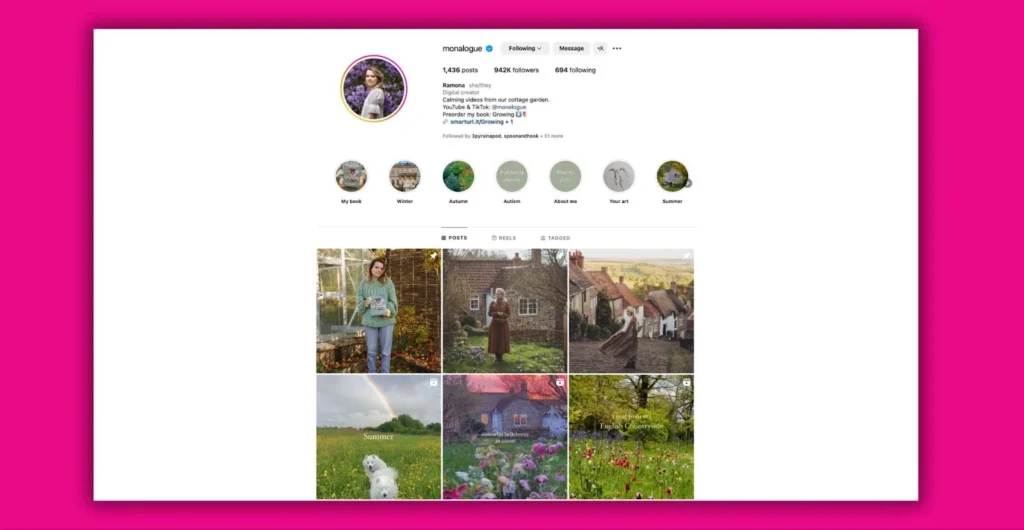
Source: @monalogue
Building a successful personal brand like Ramona’s doesn’t happen by accident. It takes clarity, consistency, and strategy—knowing your values, understanding your audience, and shaping your voice across LinkedIn, Instagram, and other social media platforms.
In this guide, you’ll learn how to build a personal brand that connects, create a personal brand that reflects your values, and develop your personal brand into something recognizable that grows your influence and opportunities in 2025.
Table of contents:
- Why successful influencers need a personal brand
- Your step-by-step guide for crafting a sticky influencer personal brand
- How to maintain your personal brand like a pro
- Build a personal brand that gets results
Why Building a Personal Brand Matters for Influencers
Your content might stop someone’s scroll, but your personal brand is what makes them smash ‘Follow.’ It’s your whole package—your voice, your values, your vibe, and how it all comes together to tell your story.
Here’s Why Personal Branding Is Important:
- It helps you stand out. Your personal brand sets you apart by offering something unique and authentic.
- It builds trust. If your brand feels honest and real, people are more likely to listen to what you have to say.
- It creates loyalty. When your followers understand who you are and what you bring to the table, they’ll keep engaging with and sharing your content.
- It attracts brand opportunities. A clear personal brand shows companies why you’re the ideal creator for their campaigns.
- It provides clarity. When you know exactly what your brand stands for, creating content becomes easier and more focused because you know what you stand for.
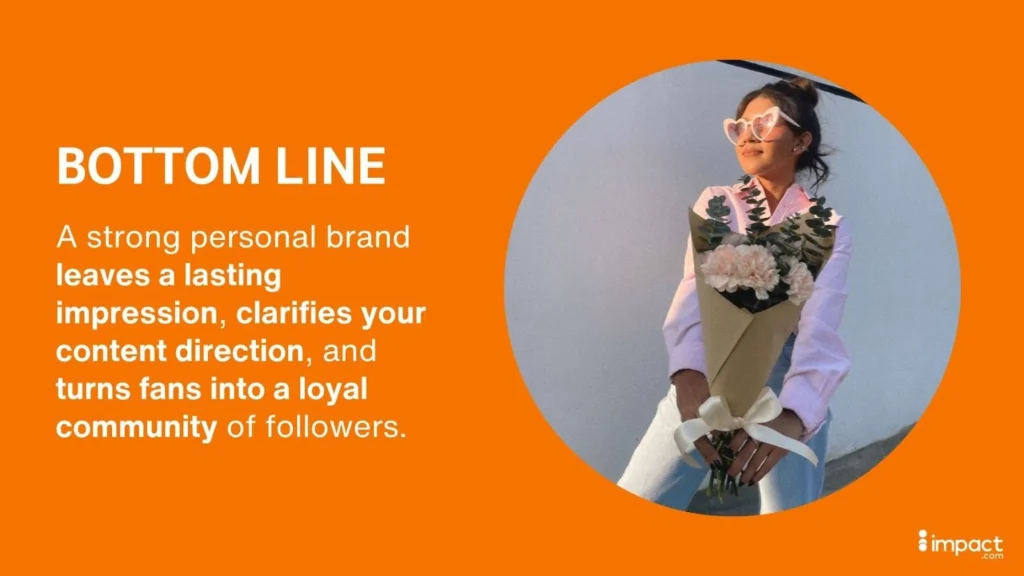
Step-by-Step Guide: How to Build a Personal Brand That Sticks
Building a personal brand takes time, effort, and genuine connections to create something that leaves a lasting impression. These steps will help you build a brand that attracts followers and opens doors to brand partnerships—all while remaining authentically you.
1. Conduct Audience Research
Your personal brand may reflect you, but the building process doesn’t start by looking inward. The best messaging insights often come straight from your audience.
Want to build a personal brand that genuinely connects? Start by getting to know your audience. Once you understand who they are and what matters to them, you can create content that resonates instead of just hoping something lands.
When your audience feels understood, something special happens—trust builds naturally, loyal fans stick around, and those genuine brand partnerships start flowing your way.
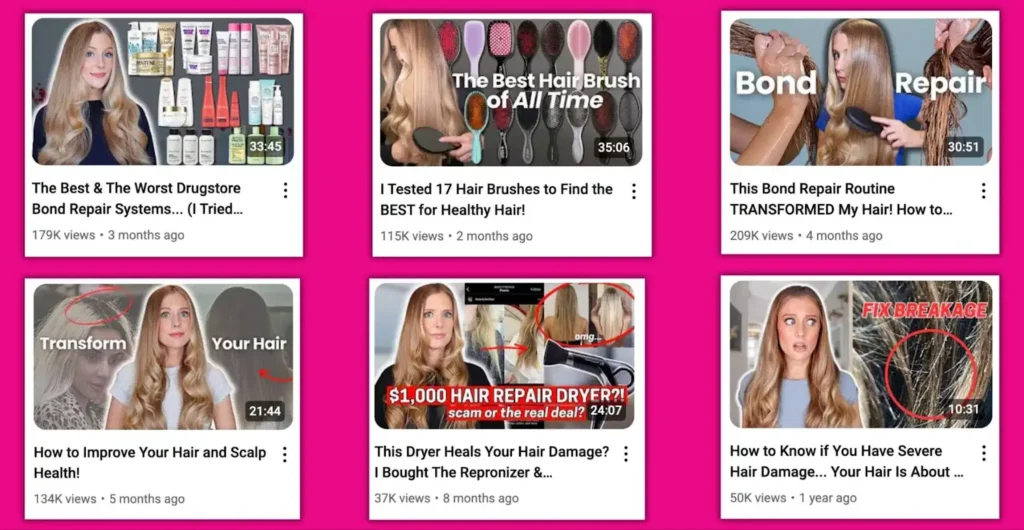
Beauty YouTuber Abbey Yung turned her bleach-damaged hair journey into her brand superpower. What started as documenting her repair process evolved into a thriving community focused on hair health and restoration.
How To Do It
Start your research process with the basics: analytics. Use tools like Instagram Insights or TikTok Analytics to get a snapshot of your audience’s age, gender, location, and interests.
This data gives you a clear picture of who already loves your content and how your audience might continue to grow.
Next, look at your best-performing posts. If your tutorials are getting tons of engagement or your behind-the-scenes clips are a hit, those are clear indicators of what works. Focus on the patterns to see what’s resonating with your audience.
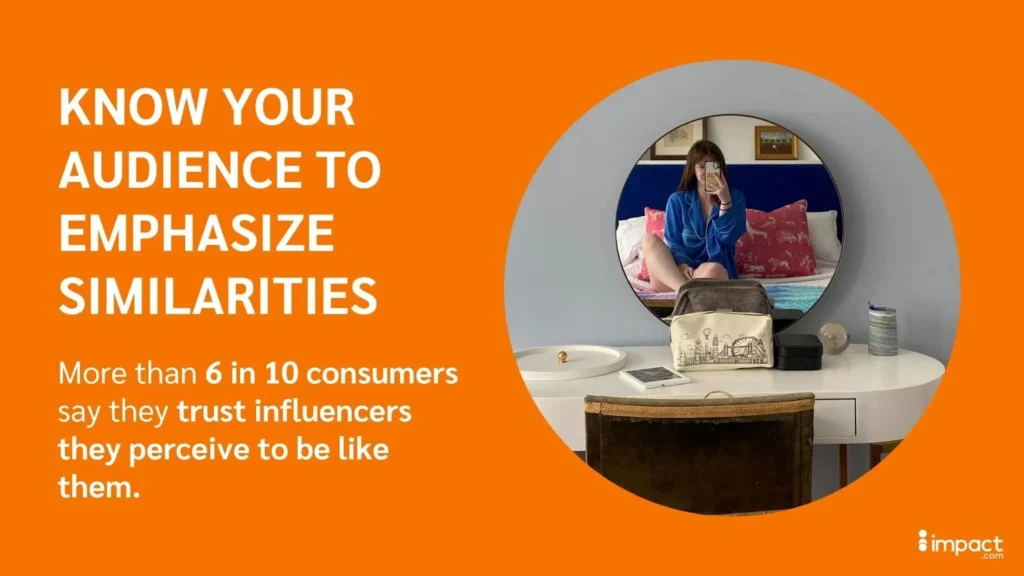
Source: The state of influencer marketing for consumers
Then, go straight to the source. Ask your followers what they want. Use Instagram polls, Stories Q&A stickers, or quick surveys to find out what they love and want more of.
Keep it simple: “What’s your favorite thing I post?” or “What would you like to see next?” You’ll be surprised how much insight you can get by just asking.
Comb through your comments and DMs. Your followers may already tell you what they need.

Creator Sebastian Esqueda looks to his audience for guidance on future content through his YouTube ‘Community’ tab.
Once you’ve got this intel, organize it in a spreadsheet or document. Highlight trends, recurring questions, and popular requests. If you notice everyone wants to know about your skincare routine or your meal prep hacks, that’s your cue to deliver.
By digging into these insights, you’ll see which parts of your online presence click with people.
Long term, this will help you strike the balance between creating content people want and crafting an online presence that feels unique.
2. Define Your Unique Value Proposition
In a world of endless trends, your unique value proposition keeps you anchored. It’s what sets you apart—the reason followers choose you and brands want to work with you.
A strong UVP makes you the standout voice in your niche, drawing in partnerships and engaged followers while keeping your content focused on what you do best.
Most importantly, it makes it easier to stay authentic and actually enjoy what you’re creating.

Source: What brands want: building successful creator partnerships in 2023
How To Do It
Start by asking yourself what lights you up. What topics can you talk about endlessly without running out of steam? What skills do you have that make you stand out? Jot down your thoughts in a journal or document.
These are your passions and strengths—and they’re key to defining your UVP. If you love what you’re creating, your audience will feel that energy too.
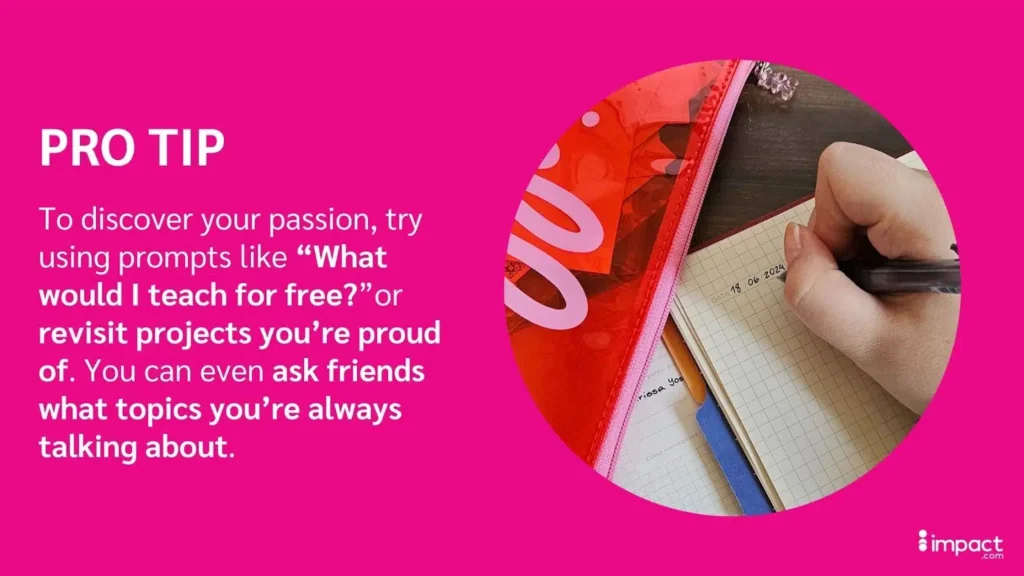
Then, take a look at the top creators in your niche. You can find them through hashtags on social media, digging through industry reports, and perusing online communities. Identify what they’re doing well and where there might be gaps or opportunities for you to stand out.
In your journal or document, summarize your findings with a few more bullet points. Focus on identifying your unique approach that feels authentic and sets you apart from others in your niche.
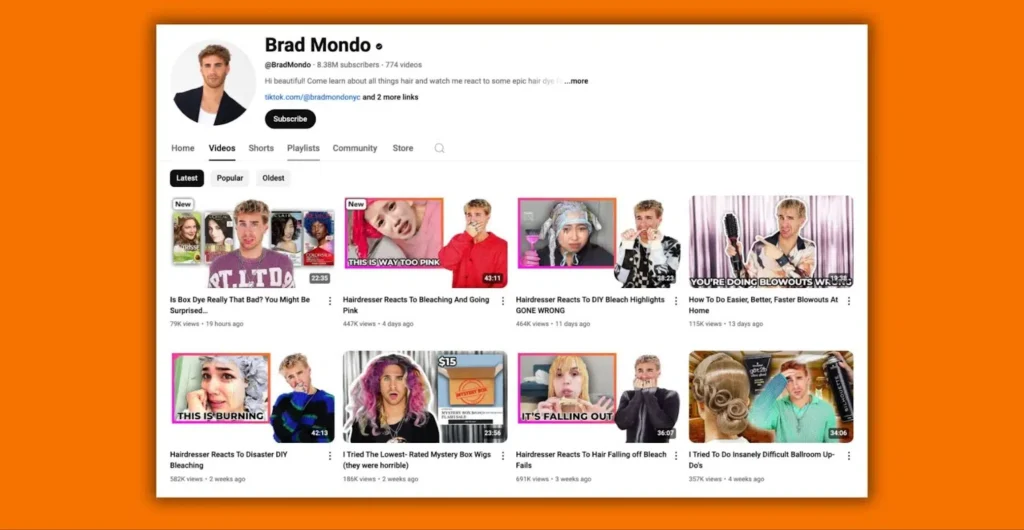
YouTuber Brad Mondo used his professional background as a hairstylist to create fun and informative “hairstylist reacts” videos that filled a gap in the market. As a result, he’s accumulated over 8 million subscribers.
From there, find the overlap between your passions, your audience’s needs, and what the market is missing. This is where your UVP lives.
Finally, record your UVP in one sentence or a few simple bullets. No need to get fancy.
For example, if you’re a wellness creator who’s all about mindfulness and sustainability, your UVP could be: “I help busy professionals create mindful routines and make eco-friendly choices.”
Keep it short, specific, and clear. Your UVP will provide the foundation for your personal brand statement, which we’ll talk about in the next section.

3. Write a Personal Brand Statement That Reflects Your Mission
Your personal brand statement is your chance to tell people who you are, what you do, and why they should care.
While your UVP focuses on what makes you different in your niche, your brand statement zooms out—bringing in your mission, values, and the impact you want to have. Think of it as the headline for your personal brand.
A strong statement keeps your messaging consistent across platforms, gives potential brand partners a reason to notice you, and helps you stay clear on your goals.
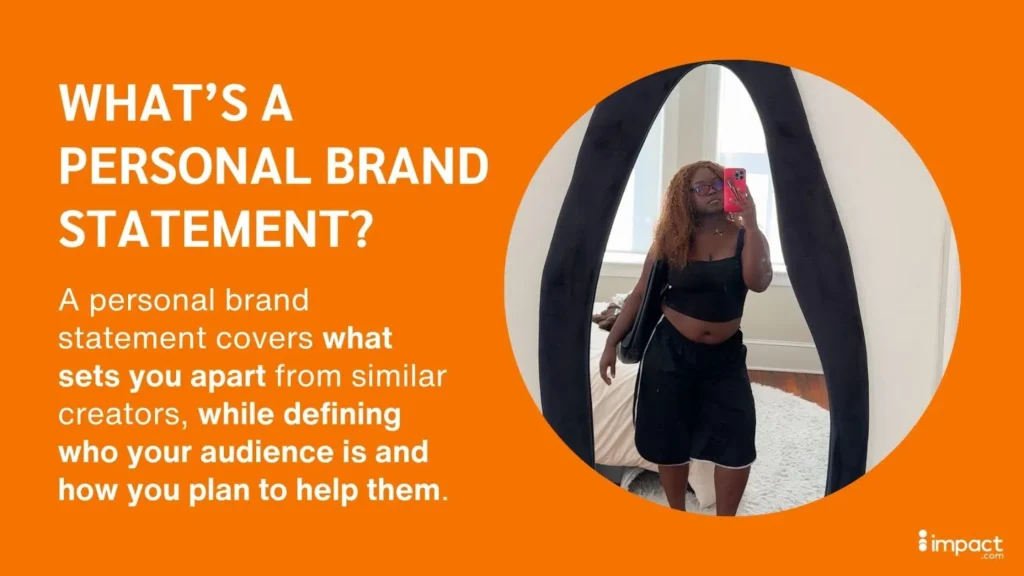
How To Do It
Start with your foundation: who you are and who you serve. Your UVP showcases your unique expertise, while audience research reveals who needs it most and why they care.
Look for the overlap—that’s where your brand shines. Write down your core themes and values, and be specific. If sustainability drives your content, make it your north star.
Now, craft your statement. Keep it short, clear, and focused on your audience’s needs.
Let’s say you’ve already come up with the following:
- Audience: Millennials who care about balancing sustainability with hectic schedules.
- UVP: “I help busy professionals create mindful routines and make eco-friendly choices.”
Your personal brand statement might evolve into, “I inspire eco-conscious millennials to live thoughtfully and sustainably, making practical changes that fit seamlessly into everyday life.”
It gets the job done without wasting a word. It’s clear, actionable, and easy to remember.
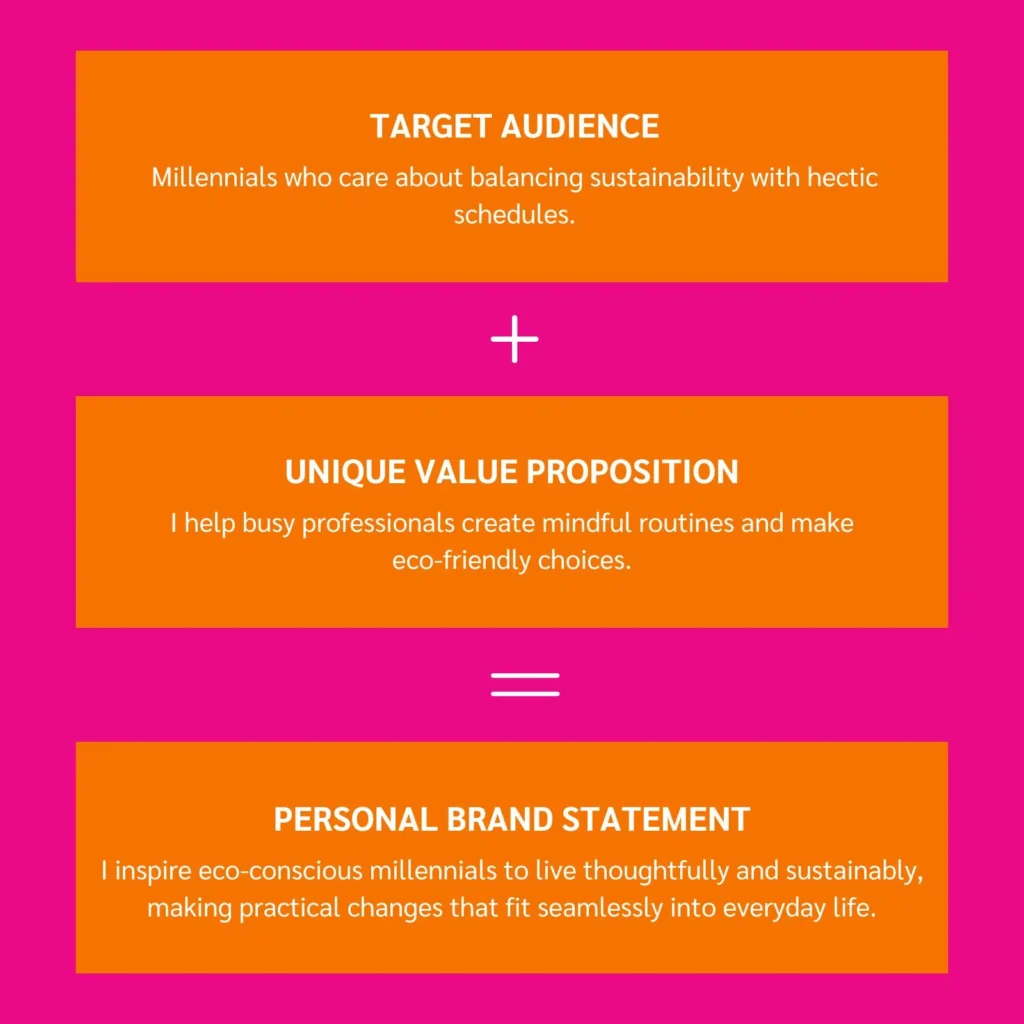
Once you’ve got a draft, get feedback. Share it with people who know you and your work—trusted peers, mentors, maybe even your audience.
Tweak it until it feels authentic. This statement is your guide, so it’s worth getting it right.
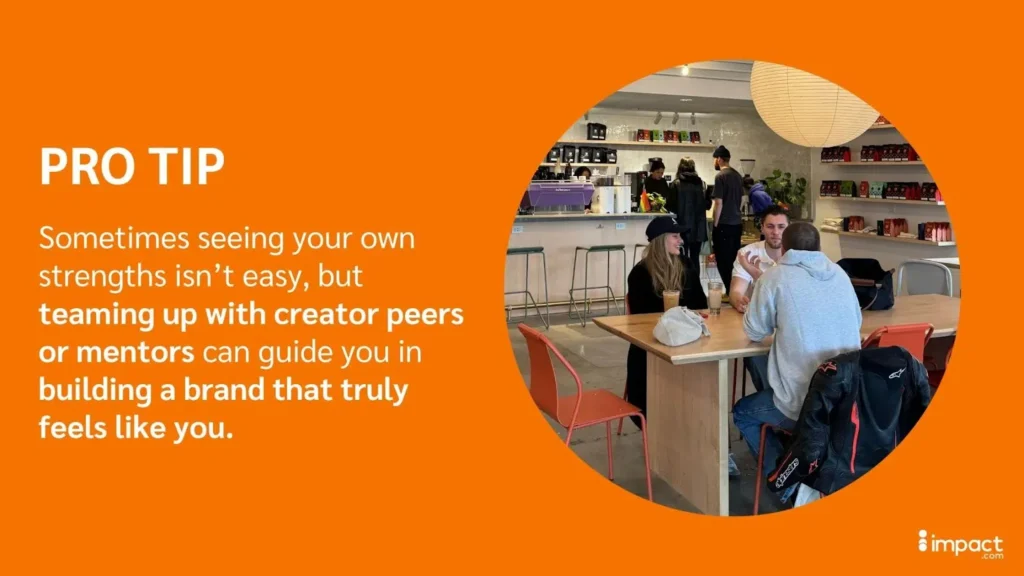
Now that your personal brand statement is polished, put it into action.
Here are some steps to take right away:
- Add it to your social bios or “about me” so people instantly know who you are
- Drop it in your media kit to nail your elevator pitch
- Use it in brand pitches to highlight your value in seconds
Use it as a general point of reference. If something doesn’t align with your statement, it probably doesn’t align with your brand.
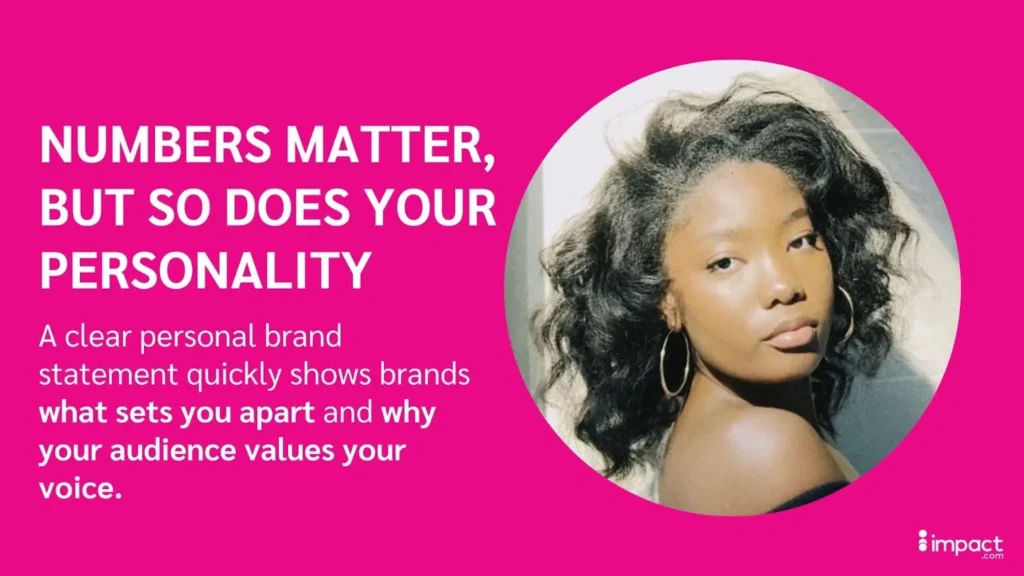
4. Create a Cohesive Aesthetic for Your Personal Brand
Now it’s time to bring your personal brand statement to life visually.
Your aesthetic is your calling card—it’s the first thing people notice about your brand, and it’s what makes them stop scrolling.
A consistent visual identity makes you recognizable across platforms and sticks with people. Plus, when your visuals are on point, brands are more likely to see you as a pro worth collaborating with.

Source: U.S. Chamber of Commerce
How To Do It
Start with the basics: pick a color palette, typography, and imagery that reflect your personality and message.
Take inspiration from your personal brand statement. Consider how it would translate visually.
For example, let’s revisit our sample personal brand statement: “I inspire eco-conscious millennials to live thoughtfully and sustainably, making practical changes that fit seamlessly into everyday life.”
This is how that statement might translate to an aesthetic:
- Color palette: Natural and calming colors tie back to the thoughtful and sustainable themes. Think soft blues and natural greens.
- Typography: A minimalist, no-nonsense font connects to the core audience. Maybe something like Montserrat or Open Sans.
- Imagery: Peaceful outdoor images and cozy, uncluttered interiors align with your core themes.
Next, document your aesthetic choices in a simple brand style guide. Include your preferred colors, fonts, filters, and examples of the kind of imagery you love. This is especially handy if you’re working with a team or outsourcing content creation.
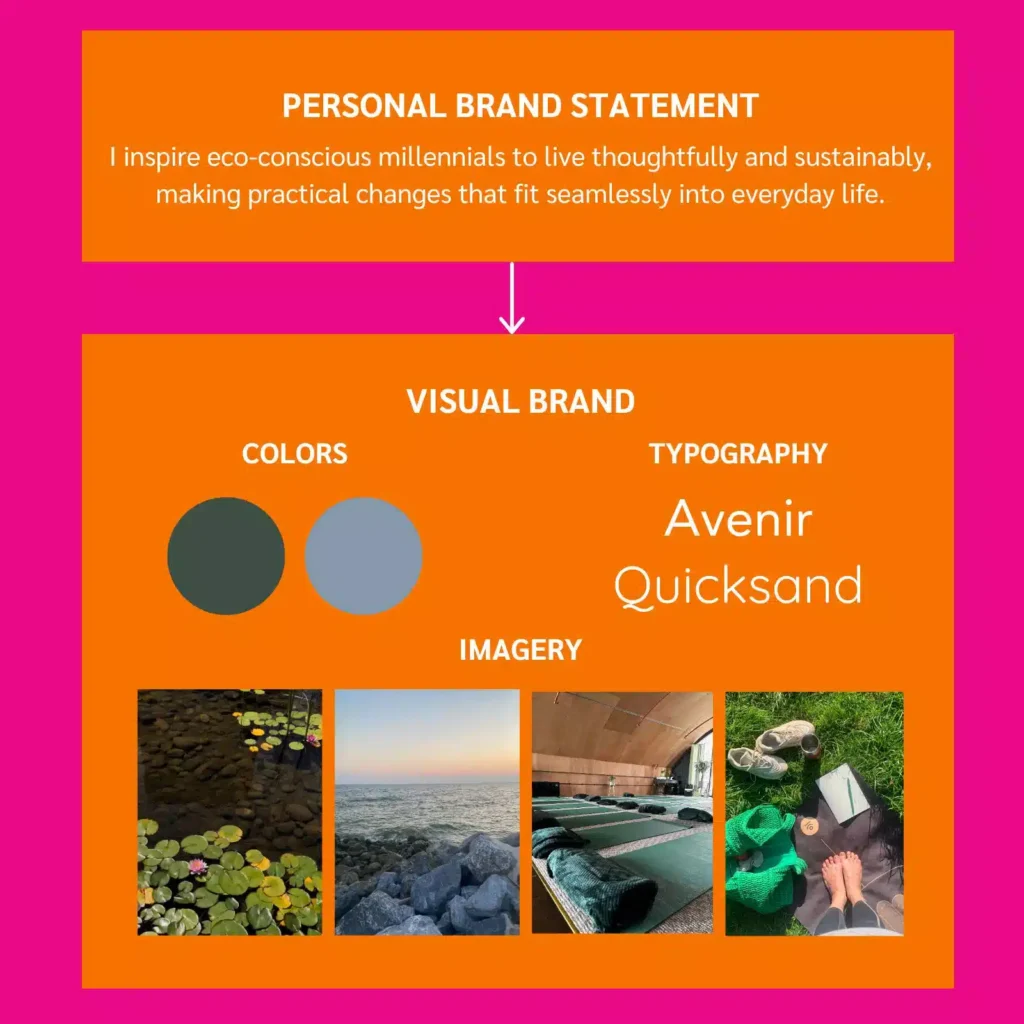
Now, focus on consistency. Use the same filters and editing styles across all your photos and videos. It’s like your visual signature—followers will instantly recognize your posts, no matter where they see them.
Templates are your best friend. Create reusable designs for your social media posts, stories, and any other content you regularly share. This will save you time and ensure everything looks polished.
When done right, your aesthetic becomes an extension of your personality and niche. Take inspiration from other successful influencers, but make it your own.

Take notes from travel influencer Kiersten Rich, known as The Blonde Abroad, who uses muted, earthy tones and a feminine chic aesthetic to create a cohesive, recognizable brand across her content.
5. Develop a Content Strategy to Grow Your Personal Brand
Strategic content captures attention and keeps it. When you post with purpose, your audience notices—and so do brands.
Stay consistent with your plan, and watch your influence grow. Soon enough, you’ll be the creator no one can ignore.
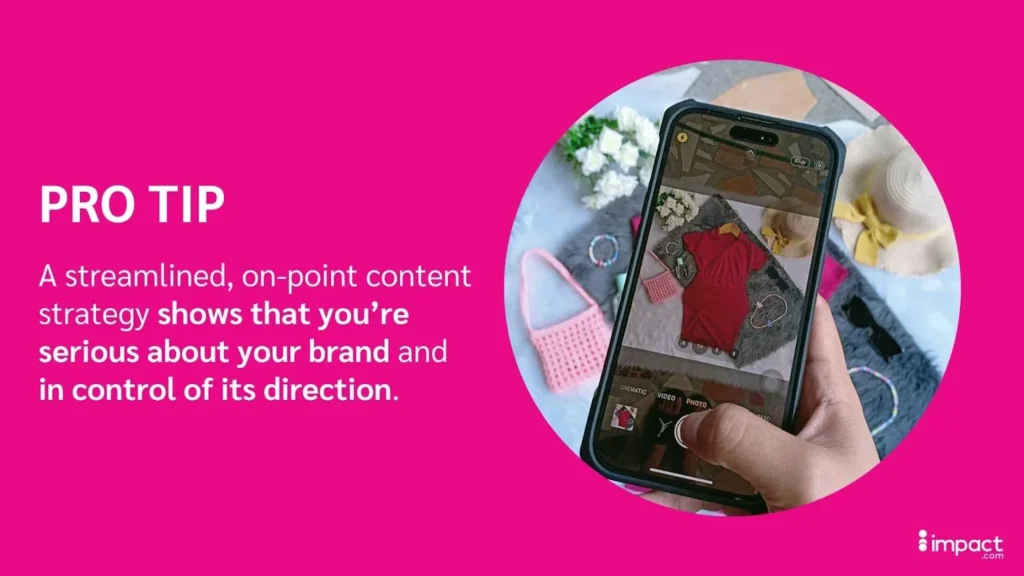
How To Do It
Start with clear goals. Whether you’re chasing higher engagement, more followers, or brand deals, know your target.
Then, pick themes that resonate with your audience and match your values.
Take a travel creator focusing on hidden gems, budget adventures, and local culture—each post reinforces their brand as the go-to guide for authentic, affordable exploration.
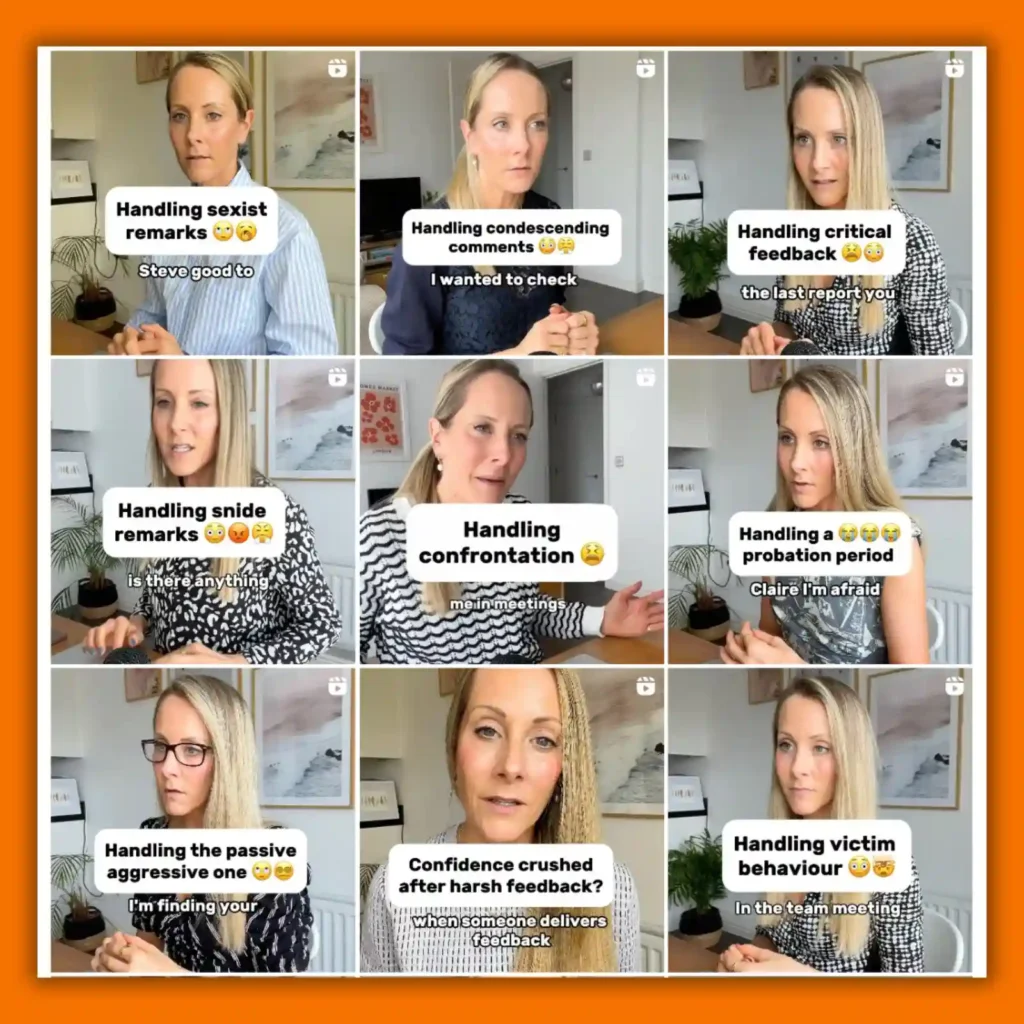
Instagram creator Claire Benjamin’s content remains laser-focused on meeting the goals that align with her personal brand: helping professionals handle problems at work and communicate effectively.
Plan ahead to stay consistent. Use tools like Later or Planoly to map out posts in advance. This keeps you organized and ensures your content stays fresh.
Don’t just post and leave, though—jump into your comments, encourage feedback, and start conversations to keep your audience invested.
Lastly, track your progress with analytics. See what’s performing and tweak your strategy based on the numbers.
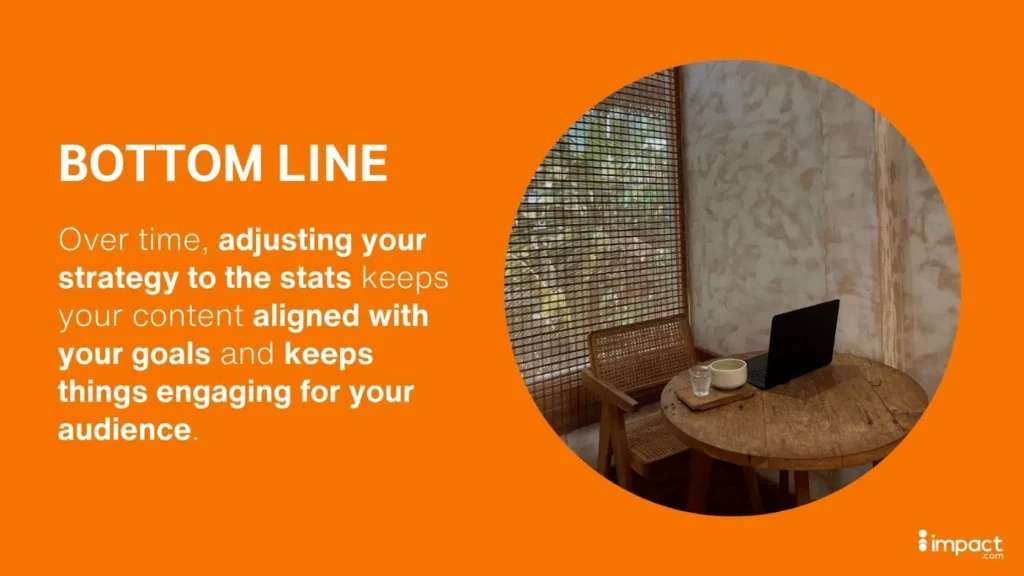
6. Collaborate With Brands That Align With Your Personal Brand
Partner with brands that match your values and style, and your personal brand soars. When collaborations feel natural, your audience trusts your recommendations as genuine advice rather than just another ad.
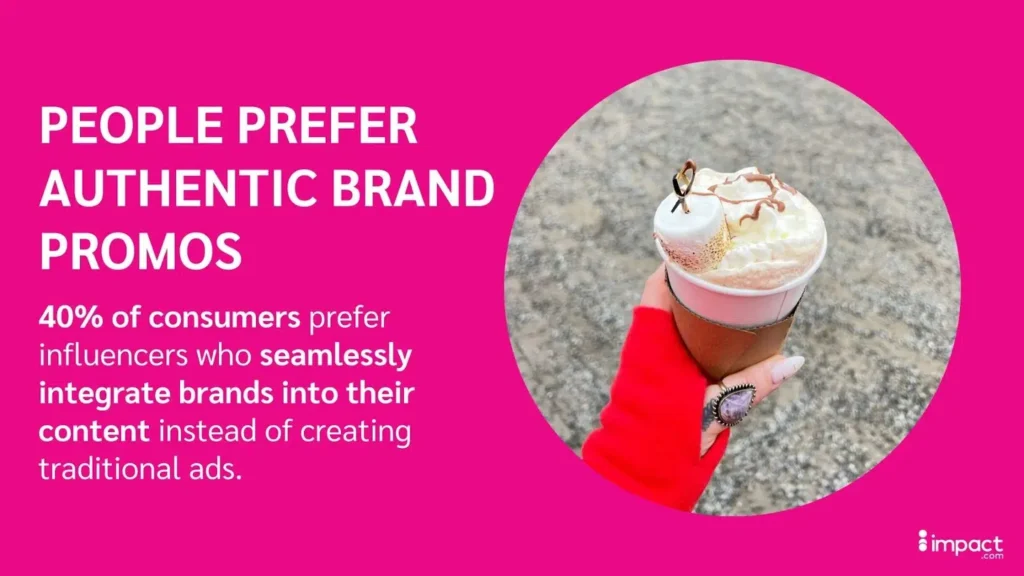
Source: The state of influencer marketing for consumers
How To Do It
Start by identifying brands that align with your values and fit your aesthetic.
For example, Emma Chamberlain’s partnership with Warby Parker highlights how her fashion-forward, relatable style aligns perfectly with the brand’s mission of accessible, trendy eyewear, creating an authentic collaboration that resonates with her audience.
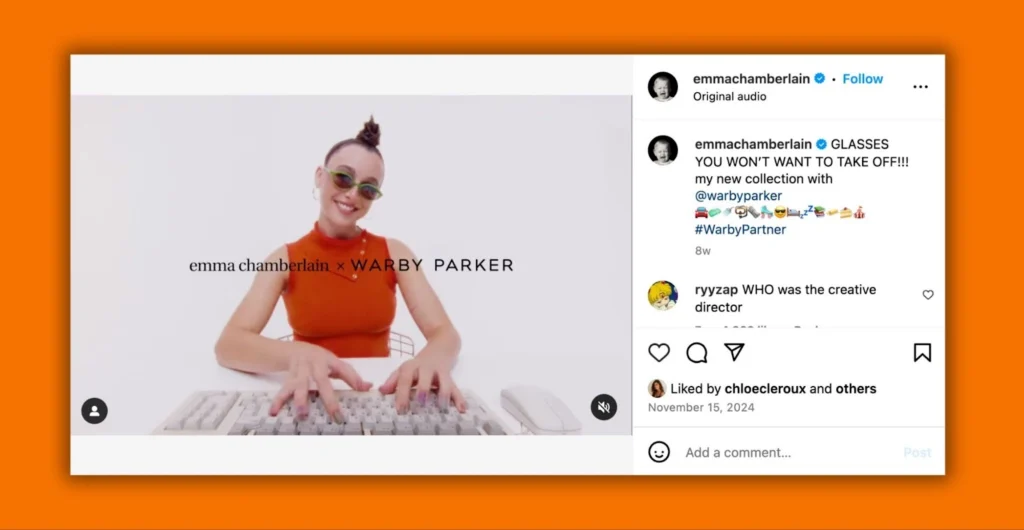
Source: @emmachamberlain
Next, make yourself stand out as a potential collaborator. Build a professional media kit that highlights your audience demographics, engagement metrics, and examples of successful partnerships.
Choose your collaborations wisely. When brand deals land in your inbox, ask yourself: Would my audience genuinely benefit from this? If it doesn’t feel authentic to your brand, passing on the opportunity protects your credibility.
Here are six strategies to help you select partnerships that boost your success and deepen audience trust.
How to Maintain and Strengthen Your Personal Brand
Building your brand is one thing—keeping it relevant and trustworthy is another.
A solid maintenance plan protects your image, helps you adapt to changes, and keeps your audience engaged. It’s how you tackle challenges like negative feedback or shifting trends while staying authentic and aligned with your values.
Here’s How to Maintain Your Personal Brand Like a Pro:
- Track your online reputation: Use listening tools like Brand24 or Mention to monitor what’s being said about you across platforms. This helps you spot issues early, understand sentiment, and strengthen your personal brand reputation through proactive communication.
- Engage with your audience professionally and promptly: Whether it’s praise, questions, or criticism, respond thoughtfully. Timely engagement shows you care and helps nurture long-term trust — a key signal of a credible personal brand.
- Review your content and collaborations regularly: Audit your partnerships, tone, and visual presence every quarter. If something no longer aligns with your values or message, refine it. Evolving with intention keeps your brand strategy authentic and your voice consistent across all channels.

As creator and entrepreneur Marcel Floruss shared on The Partnership Economy Podcast, regularly reassessing your collaborations helps your brand evolve without losing its integrity.
Build a Personal Brand That Gets Real Results
Building a standout personal brand takes work, but it’s what transforms you from content creator to community leader. When you tell your authentic story, your audience becomes your biggest supporters and brands take notice.
Focus on what makes you unique, keep it real, and watch your influence grow naturally.
To see how personal brand fits into your content creation journey, check out these resources:
- 6 ways creators can elevate their personal brand with brand collaborations [blog]
- Truth sells: Building a sustainable, authentic creator brand with Marcel Floruss [blog]
- The power of niche: How to get brand deals as a small influencer [blog]
Frequently Asked Questions About Building a Personal Brand
The best way to build your brand online is by creating a strong digital footprint across your personal website, social media channels, and professional platforms. Use audience research tools like Instagram Insights or TikTok Analytics to understand what content performs well. Maintain polished online profiles and publish consistent content that supports your personal brand statement. Participating in online communities, sharing valuable insights, and collaborating through brand partnerships help expand your reach and boost search visibility.
Personal branding helps you stand out in a competitive job market by clearly communicating your strengths, expertise, and personal qualities. It strengthens your professional network, improves your search visibility, and increases your chances of landing career opportunities, such as speaking engagements, collaborations, and brand partnerships. A strong online presence builds credibility and signals to employers or brands that you’re memorable, reliable, and aligned with their values.
Creators often struggle because they skip audience research, copy other influencers, or build an inconsistent online presence. Ignoring your brand identity leads to mixed messaging, while neglecting a brand style guide causes visual inconsistency across platforms. Other mistakes include posting without a content strategy, not updating online profiles, and avoiding networking events or professional communities that could strengthen long-term growth.
Measure success by tracking search visibility, audience growth, engagement quality, and improvements in your professional network. Look at analytics across your online profiles to understand how your content performs. Monitor increases in brand partnerships, speaking engagements, website traffic, and opportunities that come through your online presence. Regularly run a simple brand audit to check whether your message, visuals, and content still align with your personal brand statement.
You can stand out by creating a distinct brand identity rooted in your personal qualities, values, and strengths. Build credibility through a polished online presence, an effective elevator pitch, and a personal website showcasing your work. Consistent content that reflects your expertise—combined with participation in online communities and networking events—helps you grow your social capital and attract more career opportunities.






